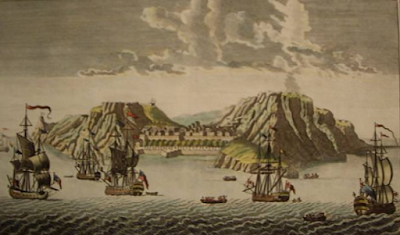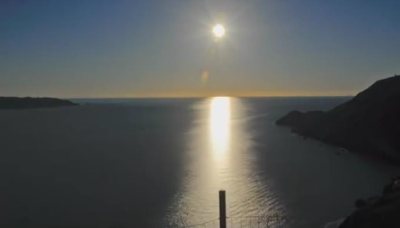73. A sighting of St Helena from a sailing ship in 1872 could not have happened on a spherical Earth
“In 1872 Capt. Gibson and crewmates, sailing the ship “Thomas Wood” from China to London, reported seeing the entirety of St. Helena Island on a clear day from 75 miles away. Factoring in their height during measurement on a ball-Earth 25,000 miles in circumference, it was found the island should have been 3,650 feet below their line of sight.”
This is yest again a historic quote of an anonymous source from a Flat Earth believer.
https://books.google.co.uk/books?id=wBo3DwAAQBAJ&pg=PT30&lpg=PT30&dq=1872+Captain+Gibson+Thomas+Wood+China+London+St.+Helena
It is not something that can ever be verified. Hardly a proof.
However the actual quote does give some indication as to the sighting.
However two things indicate the ship was clearly not in the location that the captain thought it was when he gave this figure. The ship was trying to head directly for St Helena. The fact that the writer spotted St Helena off the starboard bow, and that the captain corrected the course after St Helena was spotted shows unarguably that the ship was in a different location to the one the captain thought they were in.
The 75 mile distance is therefore certainly inaccurate. This alone makes the proof worthless.
Secondly, the quote tells us that the sighting of St Helena was fleeting. We can also presume that the captain would have simply checked himself if he could. This suggests that there may have been some extreme atmospheric phenomenon that allowed the writer to briefly make out St Helena. Yes I am talking about refraction … get used to it!
So how far away from St Helena could the Thomas Wood have been from the ship an still be seen?
I found a ship called the Thomas Wood in the Lloyds register that was a 125 foot ship built in 1859.
Masts are made up of several parts the Mast, the Topmast, the Topgallant mast and the optional Royal mast on larger ships, so the writer sighting St Helena from the Topgallant would imply that he climbed as high as he could on the ship’s mast.
The most similar ship that I could find where the height is specified is the USS Niagara.
https://en.wikipedia.org/wiki/USS_Niagara_(1813)
It was 110 feet in length and 118 feet high which was probably a little lower than the Thomas Wood, the Thomas Wood being a larger ship. At 118 feet the horizon would be 13.3 miles distant ignoring refraction, and since the account implies atmospheric phenomenon was in play I’d argue for St Helena being visible at a greater distance than that.
Was the “Thomas Wood” that far off course? I don’t know, but it could have been. Which means Dubay really can’t use this account as a proof.
< Prev 71-80 Next >
This is yest again a historic quote of an anonymous source from a Flat Earth believer.
https://books.google.co.uk/books?id=wBo3DwAAQBAJ&pg=PT30&lpg=PT30&dq=1872+Captain+Gibson+Thomas+Wood+China+London+St.+Helena
It is not something that can ever be verified. Hardly a proof.
However the actual quote does give some indication as to the sighting.
“In September, 1898, I received a letter from Australia in which the letter writer saysDubays “proof” depends on the 75 miles distance being correct. This figure came from the captain.
“In the year 1872 I was on board the ship “Thomas Wood” Capt.Gibson from China to London. Owing to making a long passage we ran short of provisions, and so short after rounding the Cape that the Captain spoke of putting into St. Helena for a supply. It was them my hobby to get the first glimpse of land, and in order to do this I would go up to the topgallant yard to make a survey just as the sun would be rising. The island was clearly in view well on the starboard bow. I reported this to Captain Gibson. He disbelieved me saying that this was impossible and that we were 75 miles distant. He however offered me paper and pencil to sketch the land I saw. This I did. He then said you are right and shaped his course accordingly. I had never seen the island before, and could not have described the shape of the island had I not seen it”
However two things indicate the ship was clearly not in the location that the captain thought it was when he gave this figure. The ship was trying to head directly for St Helena. The fact that the writer spotted St Helena off the starboard bow, and that the captain corrected the course after St Helena was spotted shows unarguably that the ship was in a different location to the one the captain thought they were in.
The 75 mile distance is therefore certainly inaccurate. This alone makes the proof worthless.
Secondly, the quote tells us that the sighting of St Helena was fleeting. We can also presume that the captain would have simply checked himself if he could. This suggests that there may have been some extreme atmospheric phenomenon that allowed the writer to briefly make out St Helena. Yes I am talking about refraction … get used to it!
So how far away from St Helena could the Thomas Wood have been from the ship an still be seen?
I found a ship called the Thomas Wood in the Lloyds register that was a 125 foot ship built in 1859.
Masts are made up of several parts the Mast, the Topmast, the Topgallant mast and the optional Royal mast on larger ships, so the writer sighting St Helena from the Topgallant would imply that he climbed as high as he could on the ship’s mast.
The most similar ship that I could find where the height is specified is the USS Niagara.
https://en.wikipedia.org/wiki/USS_Niagara_(1813)
It was 110 feet in length and 118 feet high which was probably a little lower than the Thomas Wood, the Thomas Wood being a larger ship. At 118 feet the horizon would be 13.3 miles distant ignoring refraction, and since the account implies atmospheric phenomenon was in play I’d argue for St Helena being visible at a greater distance than that.
Was the “Thomas Wood” that far off course? I don’t know, but it could have been. Which means Dubay really can’t use this account as a proof.
< Prev 71-80 Next >




Comments
Post a Comment